fuel type Alfa Romeo MiTo 2014 Owner's Manual
[x] Cancel search | Manufacturer: ALFA ROMEO, Model Year: 2014, Model line: MiTo, Model: Alfa Romeo MiTo 2014Pages: 280, PDF Size: 8.79 MB
Page 36 of 280
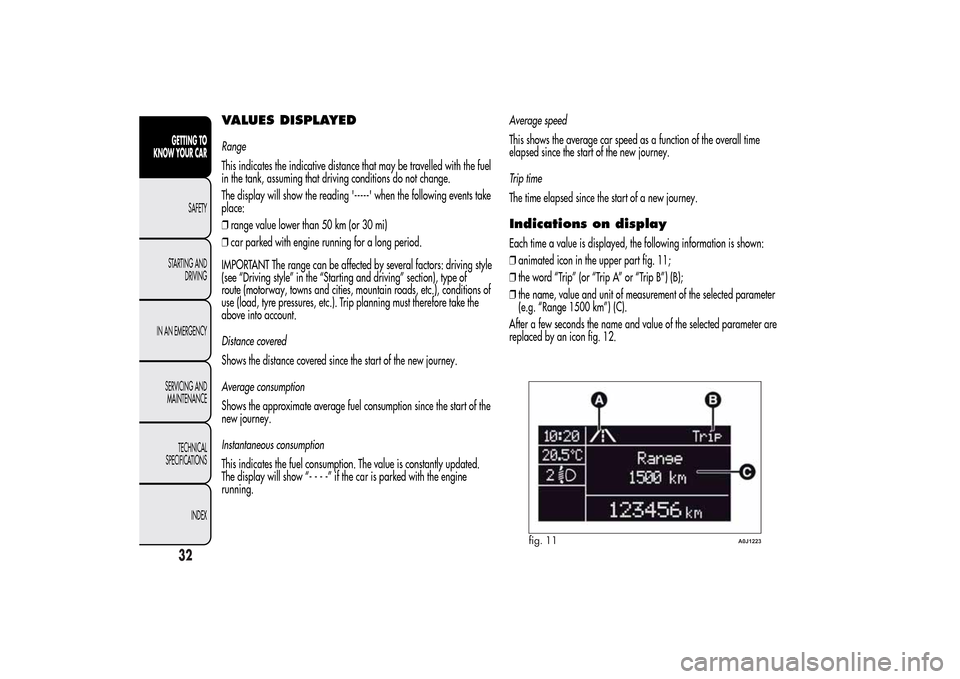
VALUES DISPLAYEDRange
This indicates the indicative distance that may be travelled with the fuel
in the tank, assuming that driving conditions do not change.
The display will show the reading '-----' when the following events take
place:
❒range value lower than 50 km (or 30 mi)
❒car parked with engine running for a long period.
IMPORTANT The range can be affected by several factors: driving style
(see “Driving style” in the “Starting and driving” section), type of
route (motorway, towns and cities, mountain roads, etc.), conditions of
use (load, tyre pressures, etc.). Trip planning must therefore take the
above into account.
Distance covered
Shows the distance covered since the start of the new journey.
Average consumption
Shows the approximate average fuel consumption since the start of the
new journey.
Instantaneous consumption
This indicates the fuel consumption. The value is constantly updated.
The display will show “----”ifthecarisparked with the engine
running.Average speed
This shows the average car speed as a function of the overall time
elapsed since the start of the new journey.
Trip time
The time elapsed since the start of a new journey.
Indications on displayEach time a value is displayed, the following information is shown:
❒animated icon in the upper part fig. 11;
❒the word “Trip” (or “Trip A” or “Trip B”) (B);
❒the name, value and unit of measurement of the selected parameter
(e.g. “Range 1500 km”) (C).
After a few seconds the name and value of the selected parameter are
replaced by an icon fig. 12.
fig. 11
A0J1223
32GETTING TO
KNOW YOUR CAR
SAFETY
STARTING AND
DRIVING
IN AN EMERGENCY
SERVICING AND
MAINTENANCE
TECHNICAL
SPECIFICATIONS
INDEX
Page 105 of 280
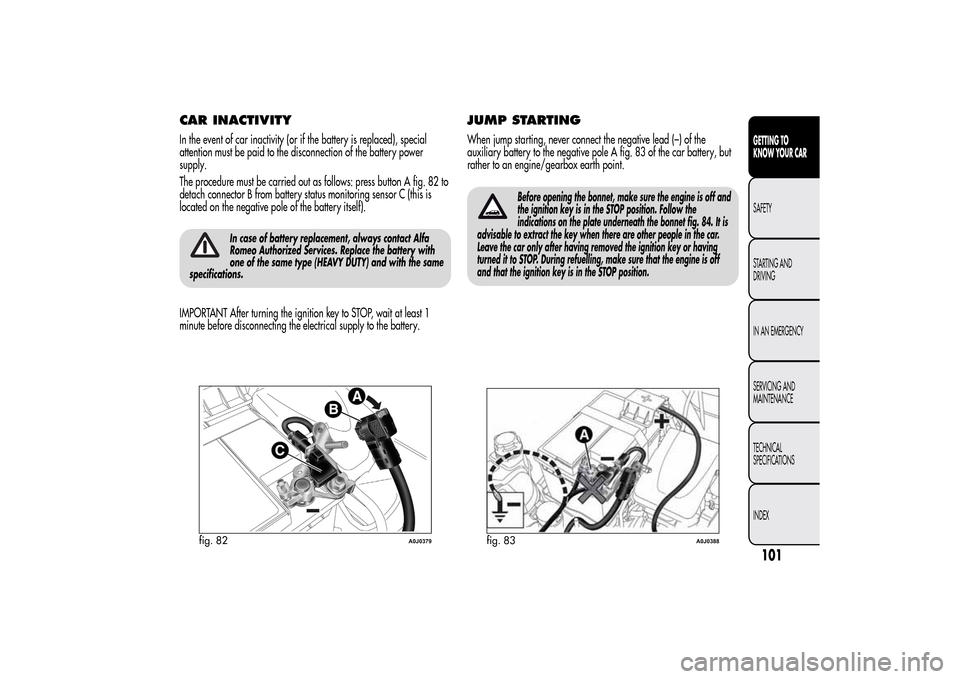
CAR INACTIVITYIn the event of car inactivity (or if the battery is replaced), special
attention must be paid to the disconnection of the battery power
supply.
The procedure must be carried out as follows: press button A fig. 82 to
detach connector B from battery status monitoring sensor C (this is
located on the negative pole of the battery itself).
In case of battery replacement, always contact Alfa
Romeo Authorized Services. Replace the battery with
one of the same type (HEAVY DUTY) and with the same
specifications.
IMPORTANT After turning the ignition key to STOP, wait at least 1
minute before disconnecting the electrical supply to the battery.
JUMP STARTINGWhen jump starting, never connect the negative lead (–) of the
auxiliary battery to the negative pole A fig. 83 of the car battery, but
rather to an engine/gearbox earth point.
Before opening the bonnet, make sure the engine is off and
the ignition key is in the STOP position. Follow the
indications on the plate underneath the bonnet fig. 84. It is
advisable to extract the key when there are other people in the car.
Leave the car only after having removed the ignition key or having
turned it to STOP. During refuelling, make sure that the engine is off
and that the ignition key is in the STOP position.
fig. 82
A0J0379
fig. 83
A0J0388
101GETTING TO
KNOW YOUR CARSAFETY
STARTING AND
DRIVING
IN AN EMERGENCY
SERVICING AND
MAINTENANCE
TECHNICAL
SPECIFICATIONS
INDEX
Page 114 of 280
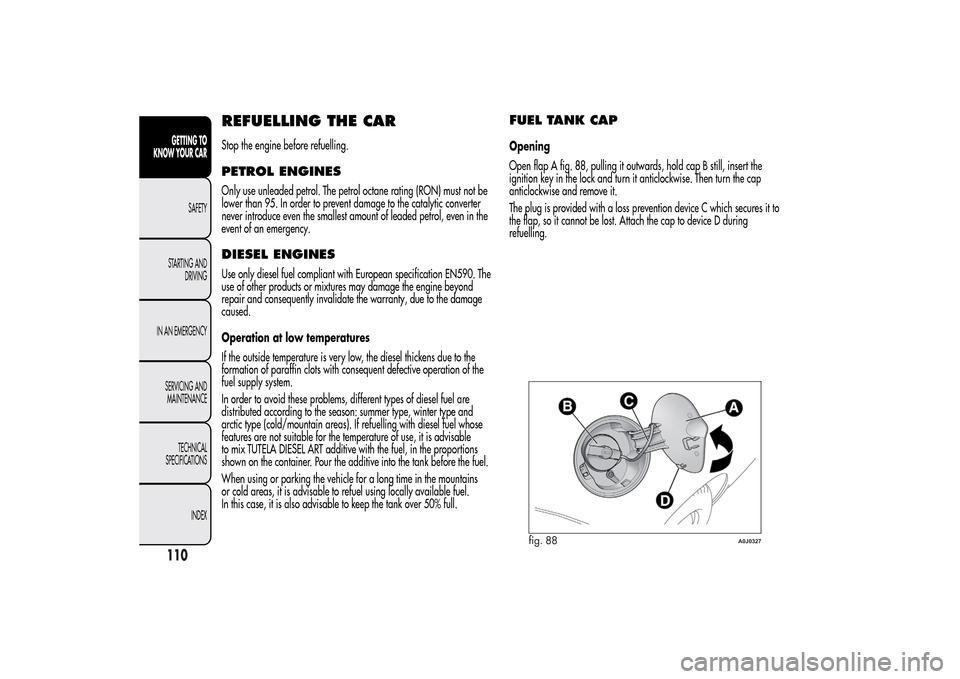
REFUELLING THE CARStop the engine before refuelling.PETROL ENGINESOnly use unleaded petrol. The petrol octane rating (RON) must not be
lower than 95. In order to prevent damage to the catalytic converter
never introduce even the smallest amount of leaded petrol, even in the
event of an emergency.DIESEL ENGINESUse only diesel fuel compliant with European specification EN590. The
use of other products or mixtures may damage the engine beyond
repair and consequently invalidate the warranty, due to the damage
caused.
Operation at low temperatures
If the outside temperature is very low, the diesel thickens due to the
formation of paraffin clots with consequent defective operation of the
fuel supply system.
In order to avoid these problems, different types of diesel fuel are
distributed according to the season: summer type, winter type and
arctic type (cold/mountain areas). If refuelling with diesel fuel whose
features are not suitable for the temperature of use, it is advisable
to mix TUTELA DIESEL ART additive with the fuel, in the proportions
shown on the container. Pour the additive into the tank before the fuel.
When using or parking the vehicle for a long time in the mountains
or cold areas, it is advisable to refuel using locally available fuel.
In this case, it is also advisable to keep the tank over 50% full.
FUEL TANK CAPOpening
Open flap A fig. 88, pulling it outwards, hold cap B still, insert the
ignition key in the lock and turn it anticlockwise. Then turn the cap
anticlockwise and remove it.
The plug is provided with a loss prevention device C which secures it to
the flap, so it cannot be lost. Attach the cap to device D during
refuelling.
fig. 88
A0J0327
110GETTING TO
KNOW YOUR CAR
SAFETY
STARTING AND
DRIVING
IN AN EMERGENCY
SERVICING AND
MAINTENANCE
TECHNICAL
SPECIFICATIONS
INDEX
Page 115 of 280
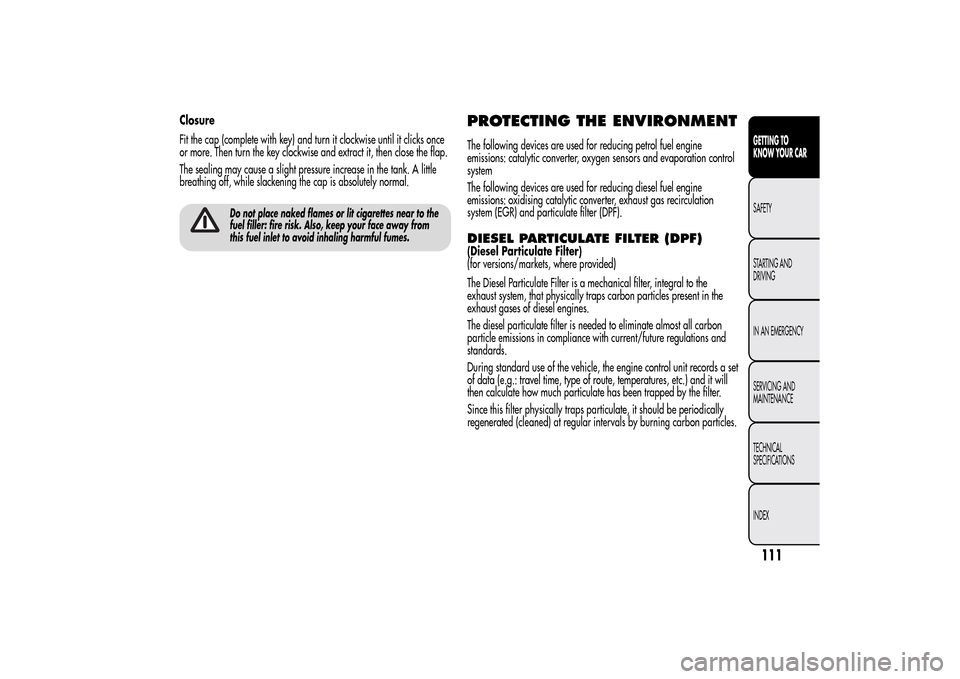
Closure
Fit the cap (complete with key) and turn it clockwise until it clicks once
or more. Then turn the key clockwise and extract it, then close the flap.
The sealing may cause a slight pressure increase in the tank. A little
breathing off, while slackening the cap is absolutely normal.
Do not place naked flames or lit cigarettes near to the
fuel filler: fire risk. Also, keep your face away from
this fuel inlet to avoid inhaling harmful fumes.
PROTECTING THE ENVIRONMENTThe following devices are used for reducing petrol fuel engine
emissions: catalytic converter, oxygen sensors and evaporation control
system
The following devices are used for reducing diesel fuel engine
emissions: oxidising catalytic converter, exhaust gas recirculation
system (EGR) and particulate filter (DPF).DIESEL PARTICULATE FILTER (DPF)(Diesel Particulate Filter)
(for versions/markets, where provided)
The Diesel Particulate Filter is a mechanical filter, integral to the
exhaust system, that physically traps carbon particles present in the
exhaust gases of diesel engines.
The diesel particulate filter is needed to eliminate almost all carbon
particle emissions in compliance with current/future regulations and
standards.
During standard use of the vehicle, the engine control unit records a set
of data (e.g.: travel time, type of route, temperatures, etc.) and it will
then calculate how much particulate has been trapped by the filter.
Since this filter physically traps particulate, it should be periodically
regenerated (cleaned) at regular intervals by burning carbon particles.
111GETTING TO
KNOW YOUR CARSAFETY
STARTING AND
DRIVING
IN AN EMERGENCY
SERVICING AND
MAINTENANCE
TECHNICAL
SPECIFICATIONS
INDEX
Page 143 of 280
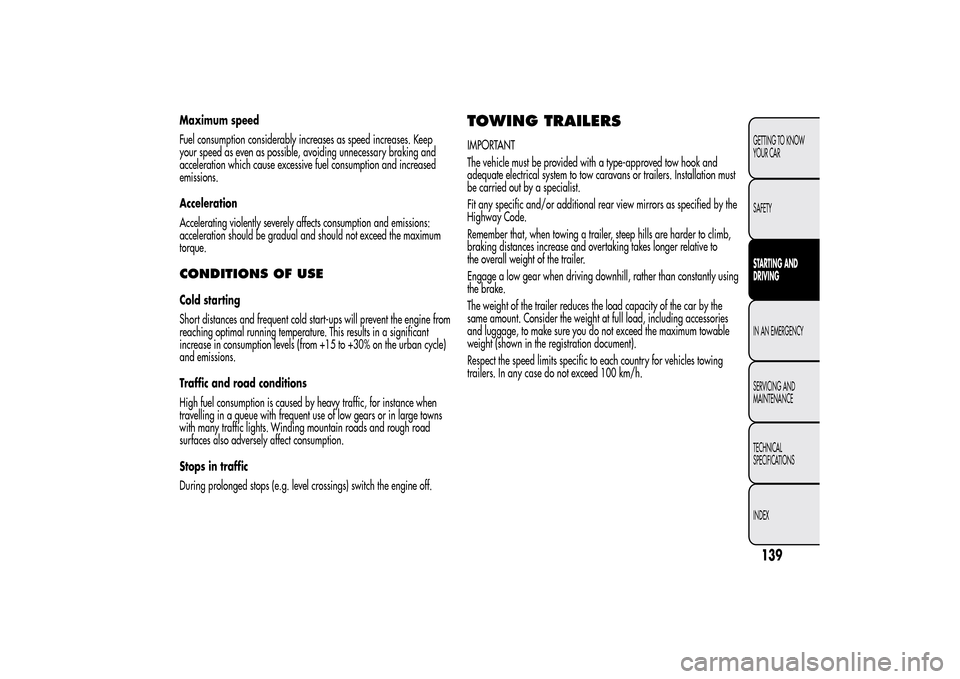
Maximum speed
Fuel consumption considerably increases as speed increases. Keep
your speed as even as possible, avoiding unnecessary braking and
acceleration which cause excessive fuel consumption and increased
emissions.
Acceleration
Accelerating violently severely affects consumption and emissions:
acceleration should be gradual and should not exceed the maximum
torque.CONDITIONS OF USECold starting
Short distances and frequent cold start-ups will prevent the engine from
reaching optimal running temperature. This results in a significant
increase in consumption levels (from +15 to +30% on the urban cycle)
and emissions.
Traffic and road conditions
High fuel consumption is caused by heavy traffic, for instance when
travelling in a queue with frequent use of low gears or in large towns
with many traffic lights. Winding mountain roads and rough road
surfaces also adversely affect consumption.
Stops in traffic
During prolonged stops (e.g. level crossings) switch the engine off.
TOWING TRAILERSIMPORTANT
The vehicle must be provided with a type-approved tow hook and
adequate electrical system to tow caravans or trailers. Installation must
be carried out by a specialist.
Fit any specific and/or additional rear view mirrors as specified by the
Highway Code.
Remember that, when towing a trailer, steep hills are harder to climb,
braking distances increase and overtaking takes longer relative to
the overall weight of the trailer.
Engage a low gear when driving downhill, rather than constantly using
the brake.
The weight of the trailer reduces the load capacity of the car by the
same amount. Consider the weight at full load, including accessories
and luggage, to make sure you do not exceed the maximum towable
weight (shown in the registration document).
Respect the speed limits specific to each country for vehicles towing
trailers. In any case do not exceed 100 km/h.
139GETTING TO KNOW
YOUR CAR
SAFETYSTARTING AND
DRIVINGIN AN EMERGENCY
SERVICING AND
MAINTENANCE
TECHNICAL
SPECIFICATIONS
INDEX
Page 204 of 280
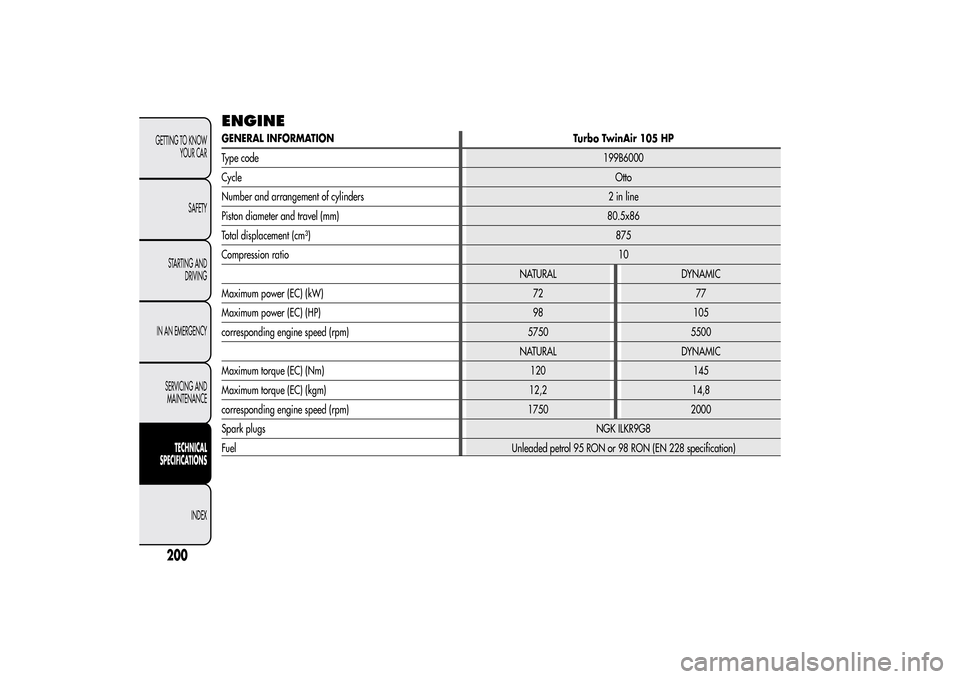
ENGINEGENERAL INFORMATION Turbo TwinAir 105 HP
Type code199B6000
CycleOtto
Number and arrangement of cylinders 2 in line
Piston diameter and travel (mm) 80.5x86
Total displacement (cm³)875
Compression ratio10
NATURAL DYNAMIC
Maximum power (EC) (kW) 72 77
Maximum power (EC) (HP) 98 105
corresponding engine speed (rpm) 5750 5500
NATURAL DYNAMIC
Maximum torque (EC) (Nm) 120 145
Maximum torque (EC) (kgm) 12,2 14,8
corresponding engine speed (rpm) 1750 2000
Spark plugsNGK ILKR9G8
Fuel Unleaded petrol 95 RON or 98 RON (EN 228 specification)
200GETTING TO KNOW
YOUR CAR
SAFETY
STARTING AND
DRIVING
IN AN EMERGENCY
SERVICING AND
MAINTENANCE
TECHNICAL
SPECIFICATIONS
INDEX
Page 205 of 280
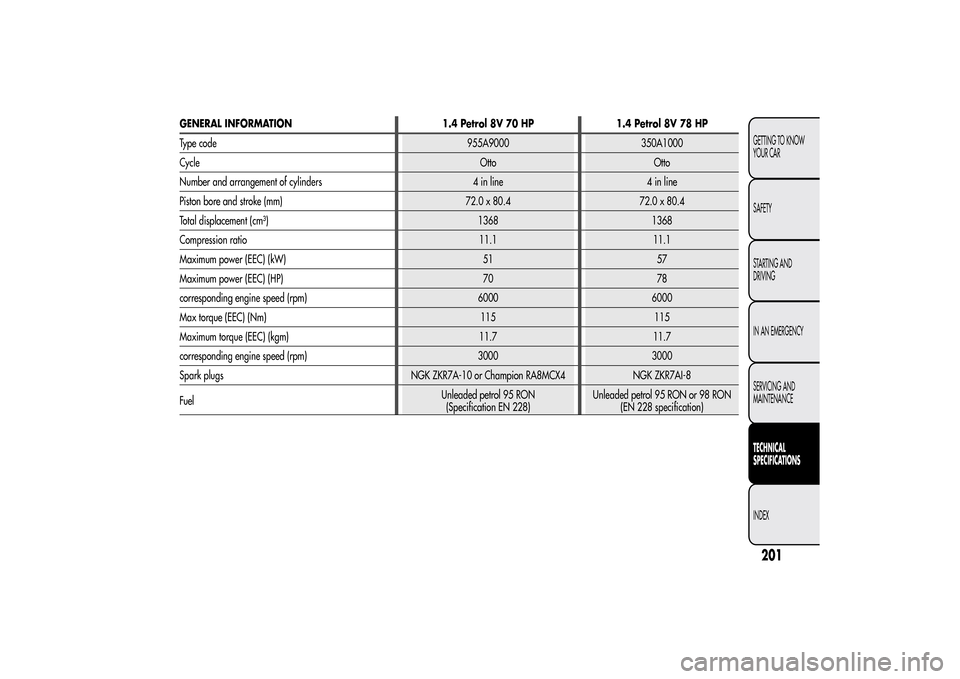
GENERAL INFORMATION 1.4 Petrol 8V 70 HP 1.4 Petrol 8V 78 HP
Type code 955A9000 350A1000
Cycle Otto Otto
Number and arrangement of cylinders 4 in line 4 in line
Piston bore and stroke (mm) 72.0 x 80.4 72.0 x 80.4
Total displacement (cm³) 1368 1368
Compression ratio 11.1 11.1
Maximum power (EEC) (kW) 51 57
Maximum power (EEC) (HP) 70 78
corresponding engine speed (rpm) 6000 6000
Max torque (EEC) (Nm) 115 115
Maximum torque (EEC) (kgm) 11.7 11.7
corresponding engine speed (rpm) 3000 3000
Spark plugs NGK ZKR7A-10 or Champion RA8MCX4 NGK ZKR7AI-8
FuelUnleaded petrol 95 RON
(Specification EN 228)Unleaded petrol 95 RON or 98 RON
(EN 228 specification)
201GETTING TO KNOW
YOUR CAR
SAFETY
STARTING AND
DRIVING
IN AN EMERGENCY
SERVICING AND
MAINTENANCETECHNICAL
SPECIFICATIONSINDEX
Page 206 of 280
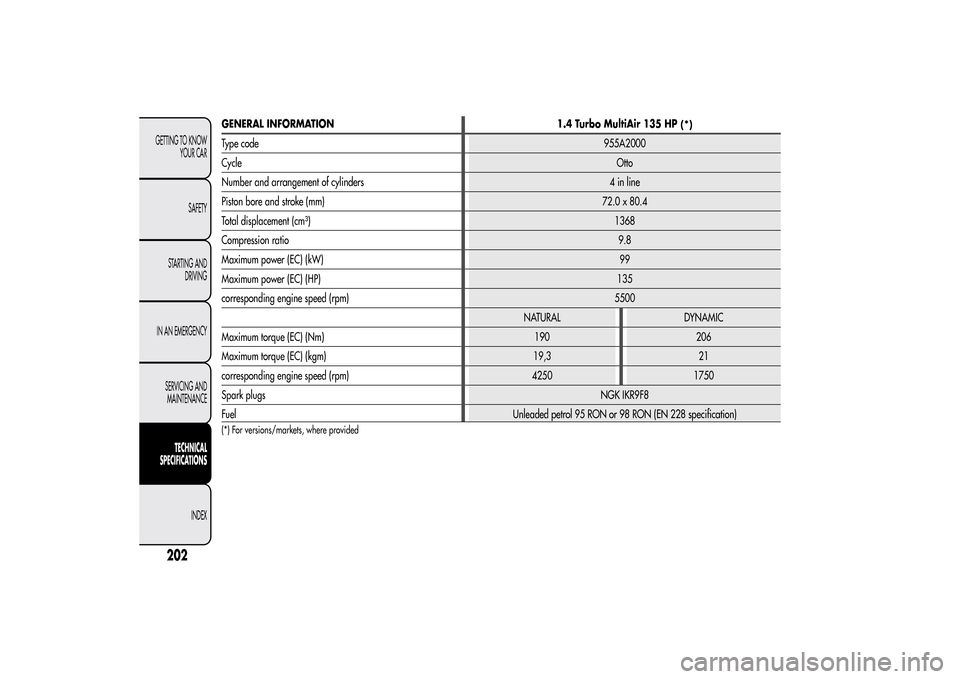
GENERAL INFORMATION
1.4 Turbo MultiAir 135 HP
(*)
Type code955A2000
CycleOtto
Number and arrangement of cylinders 4 in line
Piston bore and stroke (mm) 72.0 x 80.4
Total displacement (cm³)1368
Compression ratio9.8
Maximum power (EC) (kW)99
Maximum power (EC) (HP)135
corresponding engine speed (rpm) 5500
NATURAL DYNAMIC
Maximum torque (EC) (Nm) 190 206
Maximum torque (EC) (kgm) 19,3 21
corresponding engine speed (rpm) 4250 1750
Spark plugsNGK IKR9F8
Fuel Unleaded petrol 95 RON or 98 RON (EN 228 specification)(*) For versions/markets, where provided
202GETTING TO KNOW
YOUR CAR
SAFETY
STARTING AND
DRIVING
IN AN EMERGENCY
SERVICING AND
MAINTENANCE
TECHNICAL
SPECIFICATIONS
INDEX
Page 207 of 280
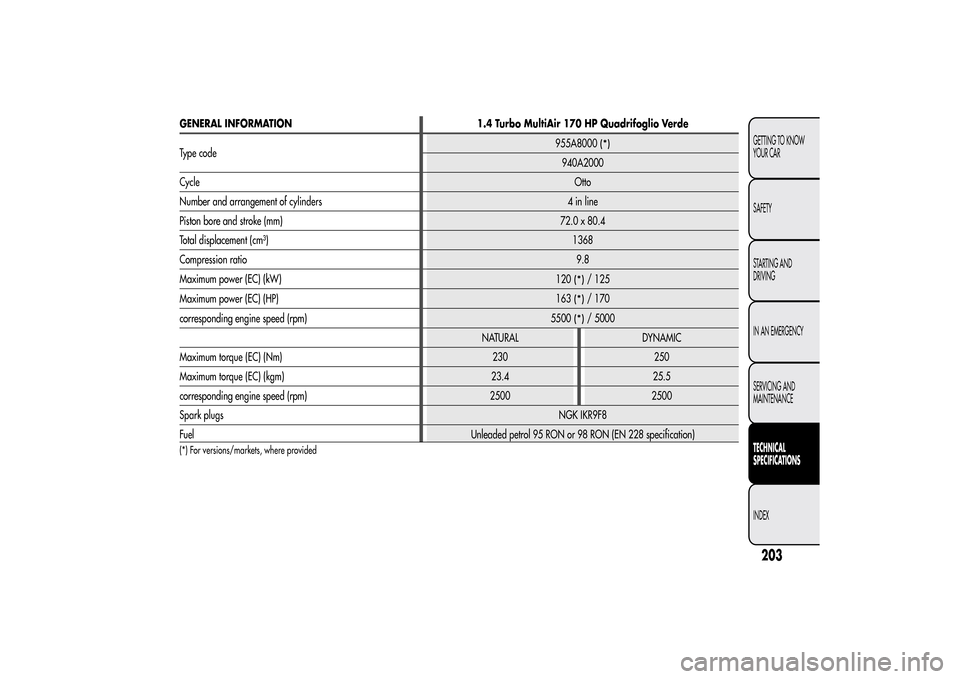
GENERAL INFORMATION 1.4 Turbo MultiAir 170 HP Quadrifoglio Verde
Type code955A8000
(*)
940A2000
CycleOtto
Number and arrangement of cylinders 4 in line
Piston bore and stroke (mm) 72.0 x 80.4
Total displacement (cm³)1368
Compression ratio9.8
Maximum power (EC) (kW)
120
(*)
/ 125
Maximum power (EC) (HP)
163
(*)
/ 170
corresponding engine speed (rpm)
5500
(*)
/ 5000
NATURAL DYNAMIC
Maximum torque (EC) (Nm) 230 250
Maximum torque (EC) (kgm) 23.4 25.5
corresponding engine speed (rpm) 2500 2500
Spark plugsNGK IKR9F8
Fuel Unleaded petrol 95 RON or 98 RON (EN 228 specification)
(*) For versions/markets, where provided
203GETTING TO KNOW
YOUR CAR
SAFETY
STARTING AND
DRIVING
IN AN EMERGENCY
SERVICING AND
MAINTENANCETECHNICAL
SPECIFICATIONSINDEX
Page 208 of 280
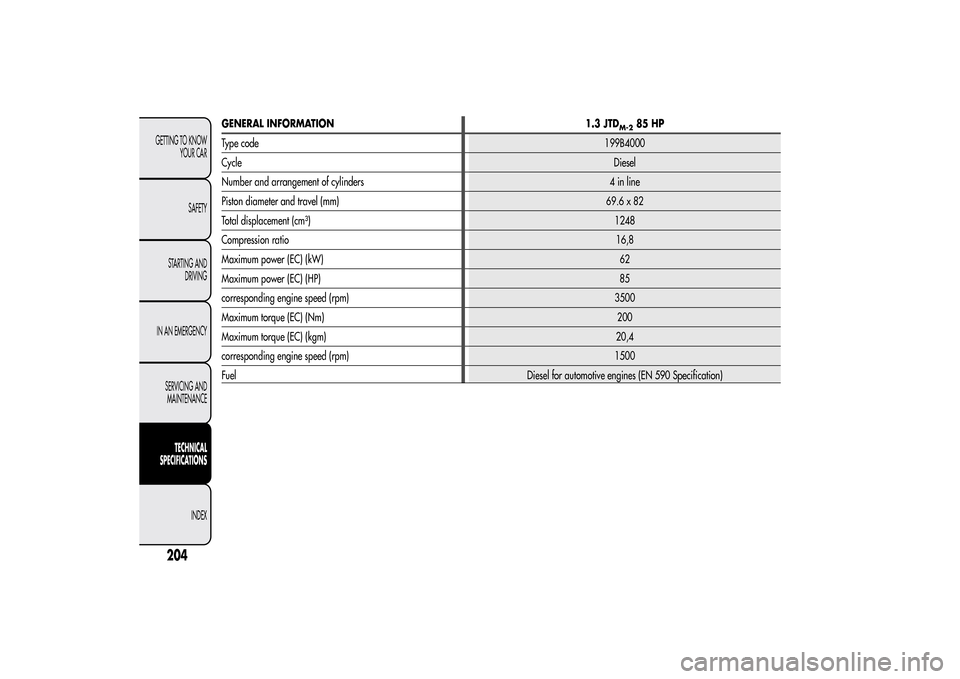
GENERAL INFORMATION 1.3 JTD
M-2
85 HP
Type code199B4000
CycleDiesel
Number and arrangement of cylinders 4 in line
Piston diameter and travel (mm) 69.6 x 82
Total displacement (cm³)1248
Compression ratio16,8
Maximum power (EC) (kW)62
Maximum power (EC) (HP)85
corresponding engine speed (rpm) 3500
Maximum torque (EC) (Nm)200
Maximum torque (EC) (kgm)20,4
corresponding engine speed (rpm) 1500
FuelDiesel for automotive engines (EN 590 Specification)
204GETTING TO KNOW
YOUR CAR
SAFETY
STARTING AND
DRIVING
IN AN EMERGENCY
SERVICING AND
MAINTENANCE
TECHNICAL
SPECIFICATIONS
INDEX